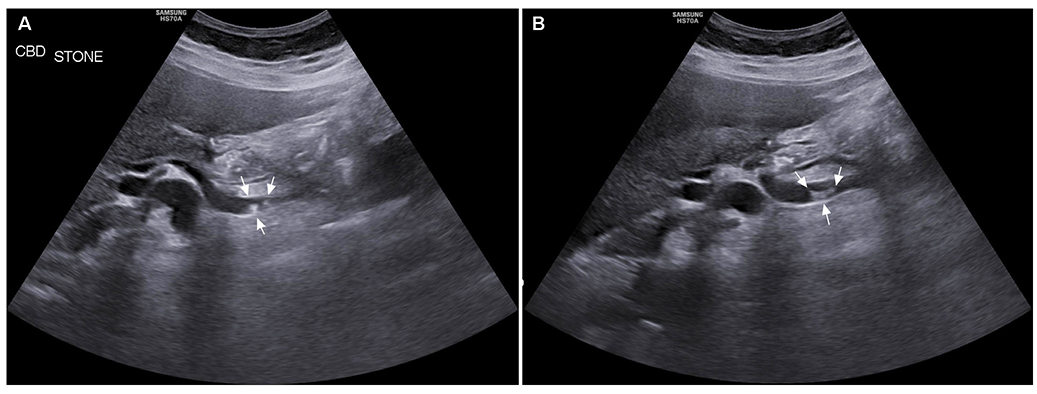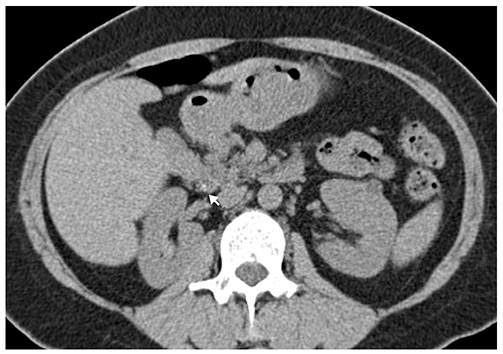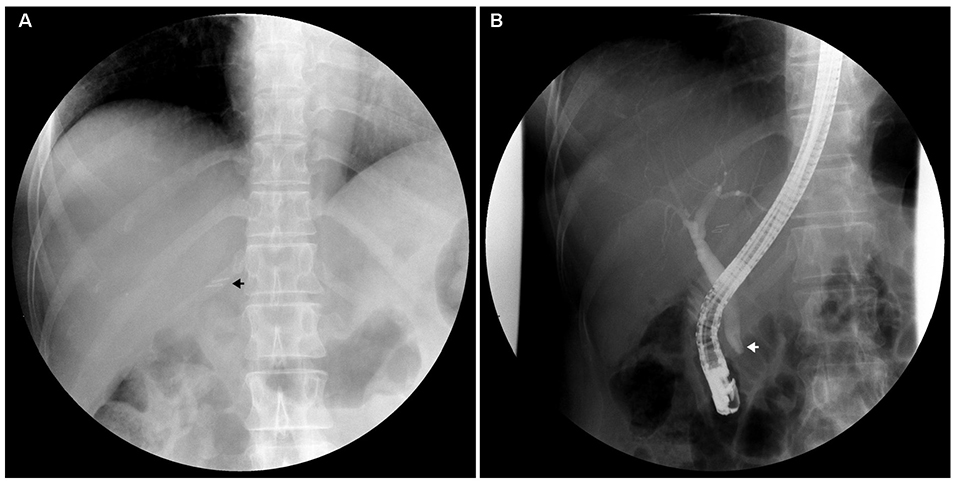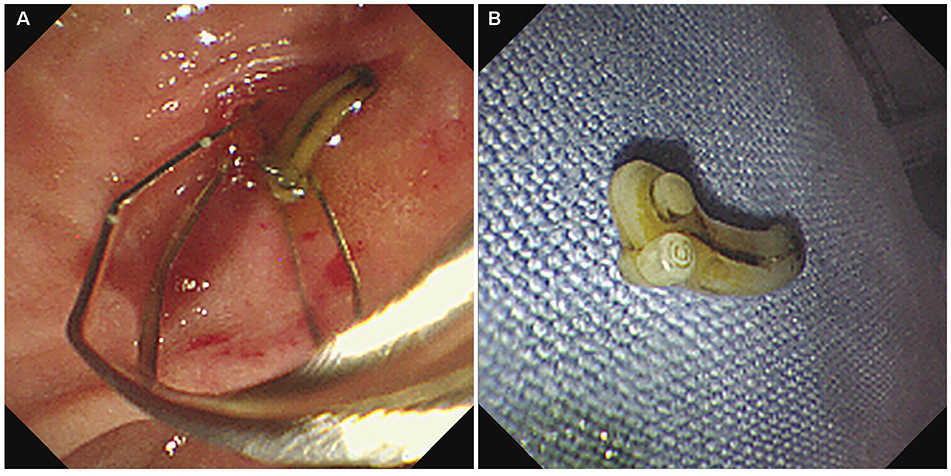Korean J Gastroenterol.
2018 Dec;72(6):313-317. 10.4166/kjg.2018.72.6.313.
Abdominal Pain Due to Hem-o-lok Clip Migration after Laparoscopic Cholecystectomy
- Affiliations
-
- 1Department of Internal Medicine, Chungnam National University College of Medicine, Daejeon, Korea. leeusgi@cnuh.co.kr
- KMID: 2429949
- DOI: http://doi.org/10.4166/kjg.2018.72.6.313
Abstract
- During laparoscopic cholecystectomy, a surgical clip is used to control the cystic duct and cystic artery. In the past, metallic clips were usually used, but over recent years, interest in the use of Hem-o-lok clips has increased. Surgical clip migration into the common bile duct (CBD) after laparoscopic cholecystectomy has rarely been reported and the majority of reported cases involved metallic clips. In this report, we describe the case of a 53-year-old woman who presented with abdominal pain caused by migration of a Hem-o-lok clip into the CBD. The patient had undergone laparoscopic cholecystectomy 10 months previously. Abdominal CT revealed an indistinct, minute, radiation-impermeable object in the distal CBD. The object was successfully removed by sphincterotomy via ERCP using a stone basket and was identified as a Hem-o-lok clip.
Keyword
MeSH Terms
Figure
Reference
-
1. Ray S, Bhattacharya SP. Endoclip migration into the common bile duct with stone formation: a rare complication after laparoscopic cholecystectomy. JSLS. 2013; 17:330–332.
Article2. Chong VH, Chong CF. Biliary complications secondary to post-cholecystectomy clip migration: a review of 69 cases. J Gastrointest Surg. 2010; 14:688–696.
Article3. Matsumoto H, Ikeda E, Mitsunaga S, Naitoh M, Furutani S, Nawa S. Choledochal stenosis and lithiasis caused by penetration and migration of surgical metal clips. J Hepatobiliary Pancreat Surg. 2000; 7:603–605.
Article4. Wasserberg N, Gal E, Fuko Z, Niv Y, Lelcuk S, Rubin M. Surgical clip found in duodenal ulcer after laparoscopic cholecystectomy. Surg Laparosc Endosc Percutan Tech. 2003; 13:387–388.
Article5. Kapoor R, Singh KJ, Suri A, et al. Hem-o-lok clips for vascular control during laparoscopic ablative nephrectomy: a single-center experience. J Endourol. 2006; 20:202–204.
Article6. Yip SK, Tan YH, Cheng C, Sim HG, Lee YM, Chee C. Routine vascular control using the Hem-o-lok clip in laparoscopic nephrectomy: animal study and clinical application. J Endourol. 2004; 18:77–81.
Article7. Walker WE, Avant GR, Reynolds VH. Cholangitis with a silver lining. Arch Surg. 1979; 114:214–215.
Article8. Raoul JL, Bretagne JF, Siproudhis L, Heresbach D, Campion JP, Gosselin M. Cystic duct clip migration into the common bile duct: a complication of laparoscopic cholecystectomy treated by endoscopic biliary sphincterotomy. Gastrointest Endosc. 1992; 38:608–611.
Article9. Kwon YW, Hur BW, Oh WS, et al. A case of common bile duct obstruction caused by migration of surgical metal clips. Korean J Med. 2005; 69:S772–S776.10. Ahn SI, Lee KY, Kim SJ, et al. Surgical clips found at the hepatic duct after laparoscopic cholecystectomy: a possible case of clip migration. Surg Laparosc Endosc Percutan Tech. 2005; 15:279–282.11. Ha SS, Lim YR, Lee JH, et al. Common bile duct stone caused by migrated surgical clip 10 years after laparoscopic cholecystectomy. Korean J Pancreas Biliary Tract. 2015; 20:42–45.
Article12. Lee KW, Lee JW, Jeong S, et al. A case of common bile duct stone formed around a surgical clip after laparoscopic cholecystectomy. Korean J Gastroenterol. 2003; 42:347–350.13. Oh HJ, Jung HJ, Chai JI, et al. A case of common bile duct stone developed due to a surgical clip as a nidus: an experience of successful management by endoscopy. Korean J Gastroenterol. 2003; 42:351–353.14. Liu Y, Ji B, Wang Y, Wang G. Hem-o-lok clip found in common bile duct after laparoscopic cholecystectomy and common bile duct exploration: a clinical analysis of 8 cases. Int J Med Sci. 2012; 9:225–227.
Article15. Qu JW, Wang GY, Yuan ZQ, Li KW. Hem-o-lok clips migration: an easily neglected complication after laparoscopic biliary surgery. Case Rep Surg. 2017; 2017:7279129.
Article16. Lucioni A, Valentin C, Gong EM, et al. Computed tomography appearance of the Lapra-Ty and Weck Hem-o-lok clips in patients who recently underwent laparoscopic urologic surgery. J Comput Assist Tomogr. 2006; 30:784–786.
Article17. Ponsky L, Cherullo E, Moinzadeh A, et al. The Hem-o-lok clip is safe for laparoscopic nephrectomy: a multi-institutional review. Urology. 2008; 71:593–596.
Article18. Cetta F, Lombardo F, Baldi C, Cappelli A, Giubbolini M. A prospective study on the long-term fate of metallic clips used during laparoscopy cholecistectomy. Gastroenterology. 1995; 108:A408.
Article19. Attwell A, Hawes R. Surgical clip migration and choledocholithiasis: a late, abrupt complication of laparoscopic cholecystectomy. Dig Dis Sci. 2007; 52:2254–2256.
Article20. Hsu TC. Comparison of holding power of metal and absorbable hemostatic clips. Am J Surg. 2006; 191:68–71.
Article
- Full Text Links
- Actions
-
Cited
- CITED
-
- Close
- Share
- Similar articles
-
- Recurrent Cholangitis due to Hem-o-lok Clip Migration after Laparoscopic Common Bile Duct Exploration Treated with Endoscopic Retrograde Cholangiopancreatography
- The usefulness and safety of Hem-o-lok clips for the closure of appendicular stump during laparoscopic appendectomy
- Intravesical Stone Formation around a Hem-O-Lok Clip after Laparoscopic Radical Prostatectomy
- Migration of a Hem-o-Lok Clip to the Ureter Following Laparoscopic Partial Nephrectomy Presenting With Lower Urinary Tract Symptoms
- Silent invasion of Hem-O-Lok clip





